Ucertify offers free demo for 1z0-829 exam. "Java SE 17 Developer", also known as 1z0-829 exam, is a Oracle Certification. This set of posts, Passing the Oracle 1z0-829 exam, will help you answer those questions. The 1z0-829 Questions & Answers covers all the knowledge points of the real exam. 100% real Oracle 1z0-829 exams and revised by experts!
Oracle 1z0-829 Free Dumps Questions Online, Read and Test Now.
NEW QUESTION 1
Given the code fragment: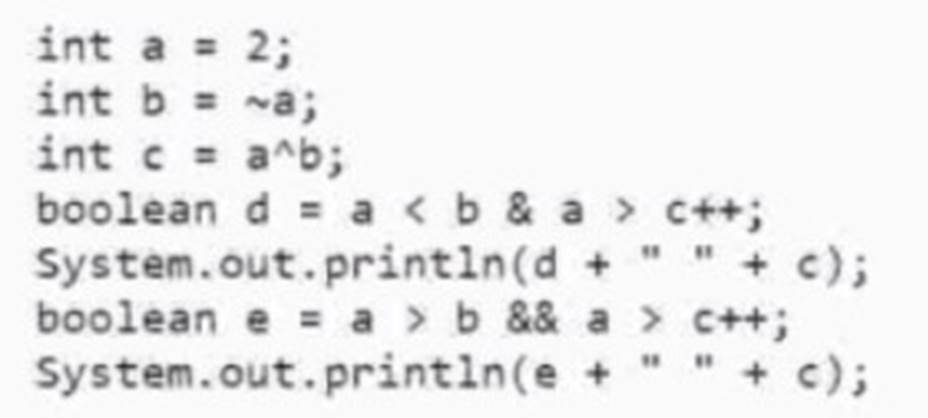
What is the result?
- A. false 1false 2
- B. true 1false 2
- C. false 1ture 2
- D. falase 0true 1
Answer: B
Explanation:
The code fragment is comparing the values of a, b, and c using the < and > operators. The first comparison, d, is checking if a is less than b and greater than c. Since a is equal to 2, b is equal to -2, and c is equal to -4, this comparison will evaluate to true. The second comparison, e, is checking if a is greater than b and a is greater than c. Since a is equal to 2, b is equal to -2, and c is equal to -4, this comparison will evaluate to false.
Therefore, the result will be true 1 false 2. References: Operators (The Java™ Tutorials > Learning the Java Language - Oracle
NEW QUESTION 2
Assuming that the data, txt file exists and has the following content:
Text1 Text2 Text3
Given the code fragment:
What is the result?
- A. text1- text2- text3- text3
- B. text1-text2-text3 text1text2 text3
- C. text1-text2-text3A java.lang.indexoutofBoundsException is thrown.
- D. text1-text2-text3 text3
Answer: D
Explanation:
The answer is D because the code fragment reads the file ??data.txt?? and collects all the lines in the file into a single string, separated by hyphens. Then, it prints the resulting string. Next, it attempts to read the fourth line in the file (index 3) and print it. However, since the file only has three lines, an IndexOutOfBoundsException is thrown. References:
✑ Oracle Certified Professional: Java SE 17 Developer
✑ Java SE 17 Developer
✑ OCP Oracle Certified Professional Java SE 17 Developer Study Guide
✑ Read contents of a file using Files class in Java
NEW QUESTION 3
Which statement is true about modules?
- A. Automatic and unnamed modules are on the module path.
- B. Only unnamed modules are on the module path.
- C. Automatic and named modules are on the module path.
- D. Only named modules are on the module path.
- E. Only automatic modules are on the module path.
Answer: C
Explanation:
A module path is a sequence of directories that contain modules or JAR files. A named module is a module that has a name and a module descriptor (module-info.class) that declares its dependencies and exports. An automatic module is a module that does not have a module descriptor, but is derived from the name and contents of a JAR file. Both named and automatic modules can be placed on the module path, and they can be resolved by the Java runtime. An unnamed module is a special module that contains all the classes that are not in any other module, such as those on the class path. An unnamed module is not on the module path, but it can read all other modules.
NEW QUESTION 4
Given:
What is the result?
- A. 1 RAINY
- B. Compilation fails
- C. 1 Snowy
- D. 0 CLOUDY
- E. 0 Snowy
Answer: E
Explanation:
The code is defining an enum class called Forecast with three values: SUNNY, CLOUDY, and RAINY. The toString() method is overridden to always return ??SNOWY??. In the main method, the ordinal value of SUNNY is printed, which is 0, followed by the value of CLOUDY converted to uppercase, which is ??CLOUDY??. However, since the
toString() method of Forecast returns ??SNOWY?? regardless of the actual value, the output
will be ??0 SNOWY??. References: Enum (Java SE 17 & JDK 17), Enum.EnumDesc (Java SE 17 & JDK 17)
NEW QUESTION 5
Given:
What is the result?
- A. 4
- B. 2
- C. 6
- D. Nothing is printed because of an indefinite loop.
- E. Compilation fails.
- F. 5
- G. A runtime exception is thrown.
- H. 3
Answer: E
Explanation:
The code will not compile because the variable ??x?? is declared as final and then it is being modified in the switch statement. This is not allowed in Java. A final variable is a variable whose value cannot be changed once it is initialized1. The switch statement tries to assign different values to ??x?? depending on the value of ??y??, which violates the final modifier. The compiler will report an error: The final local variable x cannot be assigned. It must be blank and not using a compound assignment. References: The final Keyword (The Java™ Tutorials > Learning the Java Language > Classes and Objects)
NEW QUESTION 6
Given the code fragment:
What is the result?
- A. False true true optional (Newyear)
- B. 0110
- C. True true false NewYear
- D. 010 optional (Newyear)
Answer: A
Explanation:
The code fragment is using the stream methods allMatch, anyMatch, noneMatch, and findFirst on a list of strings called specialDays. These methods are used to perform matching operations on the elements of a stream, such as checking if all, any, or none of the elements satisfy a given predicate, or finding the first element that matches a predicate1. The predicate in this case is that the string equals ??Labour?? or ??Halloween??. The output will be:
✑ False: because not all of the elements in specialDays are equal to ??Labour?? or ??Halloween??.
✑ true: because at least one of the elements in specialDays is equal to ??Labour?? or ??Halloween??.
✑ true: because none of the elements in specialDays are equal to both ??Labour?? and ??Halloween??.
✑ Optional[NewYear]: because the first element in specialDays that matches the predicate is ??NewYear??, and the findFirst method returns an Optional object that may or may not contain a non-null value2.
References: Stream (Java SE 17 & JDK 17), Optional (Java SE 17 & JDK 17)
NEW QUESTION 7
Which statement is true?
- A. The tryLock () method returns a boolean indicator immediately regardless if it has or has not managed to acquire the lock.
- B. The tryLock () method returns a boolean indicator immediately if it has managed to acquire the lock, otherwise it waits for the lock acquisition.
- C. The lock () method returns a boolean indicator immediately if it has managed to acquire the lock, otherwise it waits for the lock acquisition.
- D. The Lock () method returns a boolean indicator immediately regardless if it has or has not managed to acquire the lock
Answer: A
Explanation:
The tryLock () method of the Lock interface is a non-blocking attempt to acquire a lock. It returns true if the lock is available and acquired by the current thread, and false otherwise. It does not wait for the lock to be released by another thread. This is different from the lock () method, which blocks the current thread until the lock is acquired, and does not return any value. References: https://docs.oracle.com/en/java/javase/17/docs/api/java.base/java/util/concurrent/locks/Loc k.html#tryLock(), 3, 4, 5
NEW QUESTION 8
Given the code fragment:
What is the result?
- A. 81111
- B. 8109
- C. 777
- D. 71010
- E. 888
- F. 7107
Answer: B
Explanation:
The code fragment is creating a string variable ??a?? with the value ??Hello! Java??. Then, it is printing the index of ??Java?? in ??a??. Next, it is replacing ??Hello!?? with ??Welcome!?? in ??a??. Then, it is printing the index of ??Java?? in ??a??. Finally, it is creating a new StringBuilder object ??b?? with the value of ??a?? and printing the index of ??Java?? in ??b??. The output will be 8109 because the index of ??Java?? in ??a?? is 8, the index of ??Java?? in ??a?? after replacing ??Hello!?? with ??Welcome!?? is 10, and the index of ??Java?? in ??b?? is 9. References: Oracle Java SE 17 Developer source and documents: [String (Java SE 17 & JDK 17)], [StringBuilder (Java SE 17 & JDK 17)]
NEW QUESTION 9
Given the code fragment: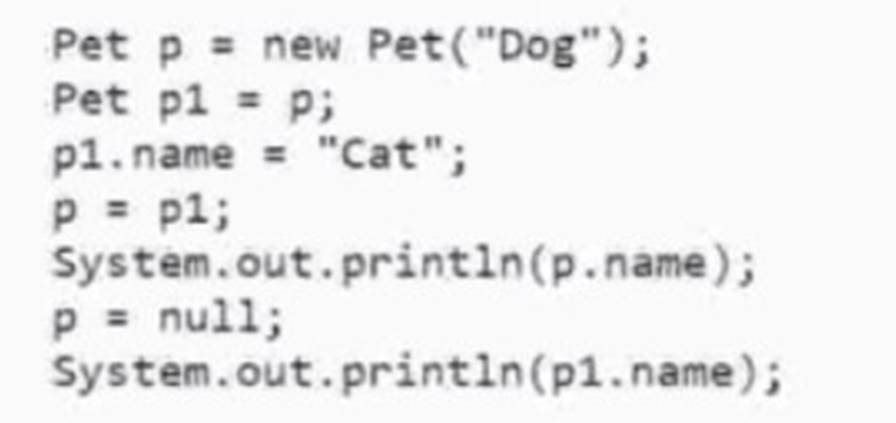
What is the result?
- A. A.Cat Dog
- B. A NullPointerException is thrown CatCat
- C. Dog Dog
- D. Cat null
Answer: D
Explanation:
The answer is E because the code fragment creates a new Pet object with the name ??Dog?? and assigns it to the variable p. Then, it assigns p to p1. Next, it changes the name of p1 to ??Cat??. Then, it assigns p1 to p. Finally, it sets p to null and prints the name of p and p1. The output will be ??Cat?? and ??null?? because p is set to null and p1 still points to the Pet object with the name ??Cat??.
NEW QUESTION 10
Given the code fragment: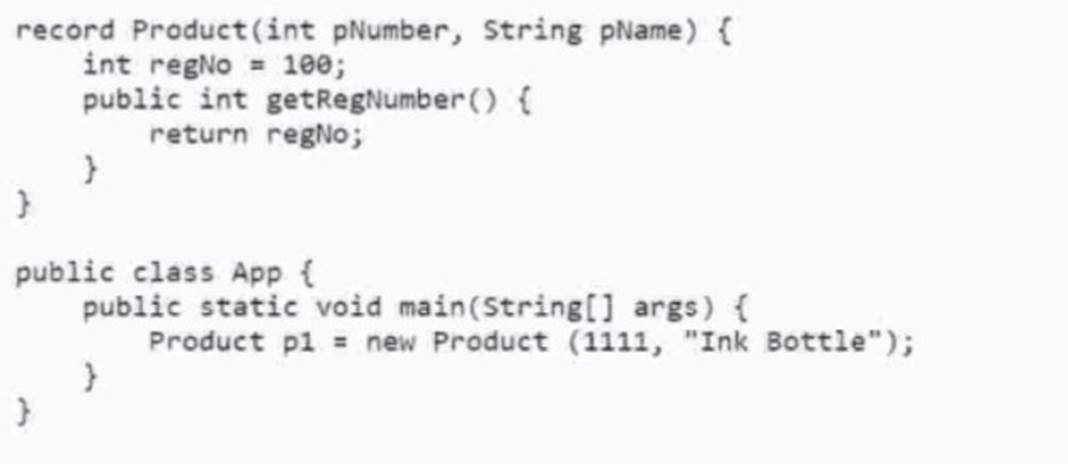
Which action enables the code to compile?
- A. Replace record with void.
- B. Remove the regNO initialization statement.
- C. Make the regNo variable static.
- D. Replace thye regNo variable static
- E. Make the regNo variable public
Answer: E
Explanation:
The code will compile if the regNo variable is made public. This is because the regNo variable is being accessed in the main method of the App class, which is outside the scope of the Product class. Making the regNo variable public will allow it to be accessed from outside the class. References: https://education.oracle.com/products/trackp_OCPJSE17, https://mylearn.oracle.com/ou/learning-path/java-se-17-developer/99487, https://docs.oracle.com/javase/tutorial/java/javaOO/accesscontrol.html
NEW QUESTION 11
Given the product class:
And the shop class: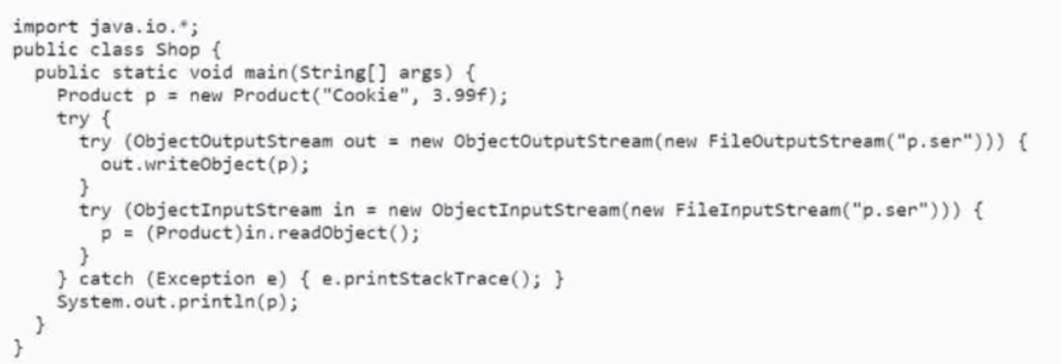
What is the result?
- A. Cookie 2.99 2.99
- B. Cookie 3.99 2.99
- C. Cookie 0.0 0.0
- D. An exception is produced at runtime
- E. Compilation fails
- F. Cookie 0.0 2.99
Answer: E
Explanation:
The code fragment will fail to compile because the readObject method in the Product class is missing the @Override annotation. The readObject method is a special method that is used to customize the deserialization process of an object. It must be declared as private, have no return type, and take a single parameter of type ObjectInputStream. It must also be annotated with @Override to indicate that it overrides the default behavior of the ObjectInputStream class. Without the @Override annotation, the compiler will treat the readObject method as a normal method and not as a deserialization hook. Therefore, the code fragment will produce a compilation error. References: Object Serialization - Oracle, [ObjectInputStream (Java SE 17 & JDK 17) - Oracle]
NEW QUESTION 12
Which two code fragments compile?
A)
B)
C)
D)
E)
- A. Option A
- B. Option B
- C. Option C
- D. Option D
- E. Option E
Answer: BE
Explanation:
The two code fragments that compile are B and E. These are the only ones that use the correct syntax for declaring and initializing a var variable. The var keyword is a reserved type name that allows the compiler to infer the type of the variable based on the initializer expression. However, the var variable must have an initializer, and the initializer must not be null or a lambda expression. Therefore, option A is invalid because it does not have an initializer, option C is invalid because it has a null initializer, and option D is invalid because it has a lambda expression as an initializer. Option B is valid because it has a String initializer, and option E is valid because it has an int initializer. https://docs.oracle.com/en/java/javase/17/language/local-variable-type-inference.html
NEW QUESTION 13
Given the code fragment: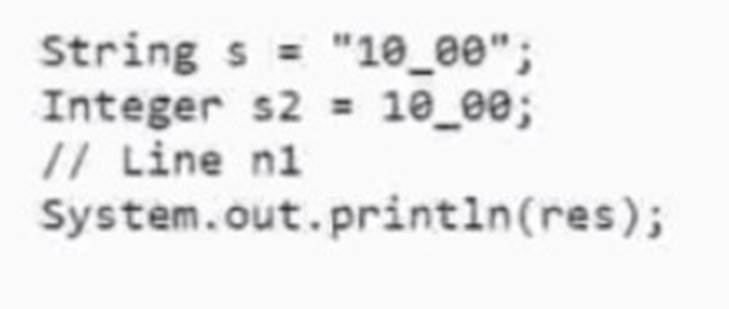
Which two statements at Line nl independently enable you to print 1250?
- A. Integer res = 250 + integer.parseint (s)
- B. Integer res = 250 + s:
- C. Integer res = 250 + integer (s2):
- D. Integer res= 250 + s2;
- E. Integer res = 250 + integer . valueof (s);
- F. Integer res = 250; Res = + s2;
Answer: AE
Explanation:
The code fragment is creating a string variable ??s?? with the value ??10_00?? and an integer variable ??s2?? with the value 10. The string ??s?? is using an underscore as a separator for readability, which is allowed in Java SE 171. The question is asking for two statements that can add 250 to the numeric value of ??s?? and assign it to an integer variable ??res??. The correct answers are A and E because they use the methods parseInt and valueOf of the Integer class to convert the string ??s?? to an integer. Both methods interpret the string as a signed decimal integer and return the equivalent int or Integer value23. The other options are incorrect because they either use invalid syntax, such as B and C, or they do not convert the string ??s?? to an integer, such as D and F. References: Binary Literals (The Java™ Tutorials > Learning the Java Language > Numbers and Strings), Integer (Java SE 17 & JDK 17), Integer (Java SE 17 & JDK 17)
NEW QUESTION 14
Given the code fragments:
Which action prints Wagon : 200?
- A. At line n1, implement the java.io, Serializable interface.
- B. At line n3, replace readObject (0 with readLine().
- C. At Line n3, replace Car with LuxurayCar.
- D. At Line n1, implement the java.io.AutoCloseable interface
- E. At line n2, in the main method signature, add throws IOException, ClassCastException.
- F. At line n2, in the main method signature, add throws IoException, ClassNotFoundException.
Answer: F
Explanation:
The code fragment is trying to read an object from a file using the ObjectInputStream class. This class throws an IOException and a ClassNotFoundException. To handle these exceptions, the main method signature should declare that it throws these exceptions. Otherwise, the code will not compile. If the main method throws these exceptions, the code will print Wagon : 200, which is the result of calling the toString method of the LuxuryCar object that was written to the
file. References: ObjectInputStream (Java SE 17 & JDK 17) - Oracle, ObjectOutputStream (Java SE 17 & JDK 17) - Oracle
NEW QUESTION 15
Given the code fragments: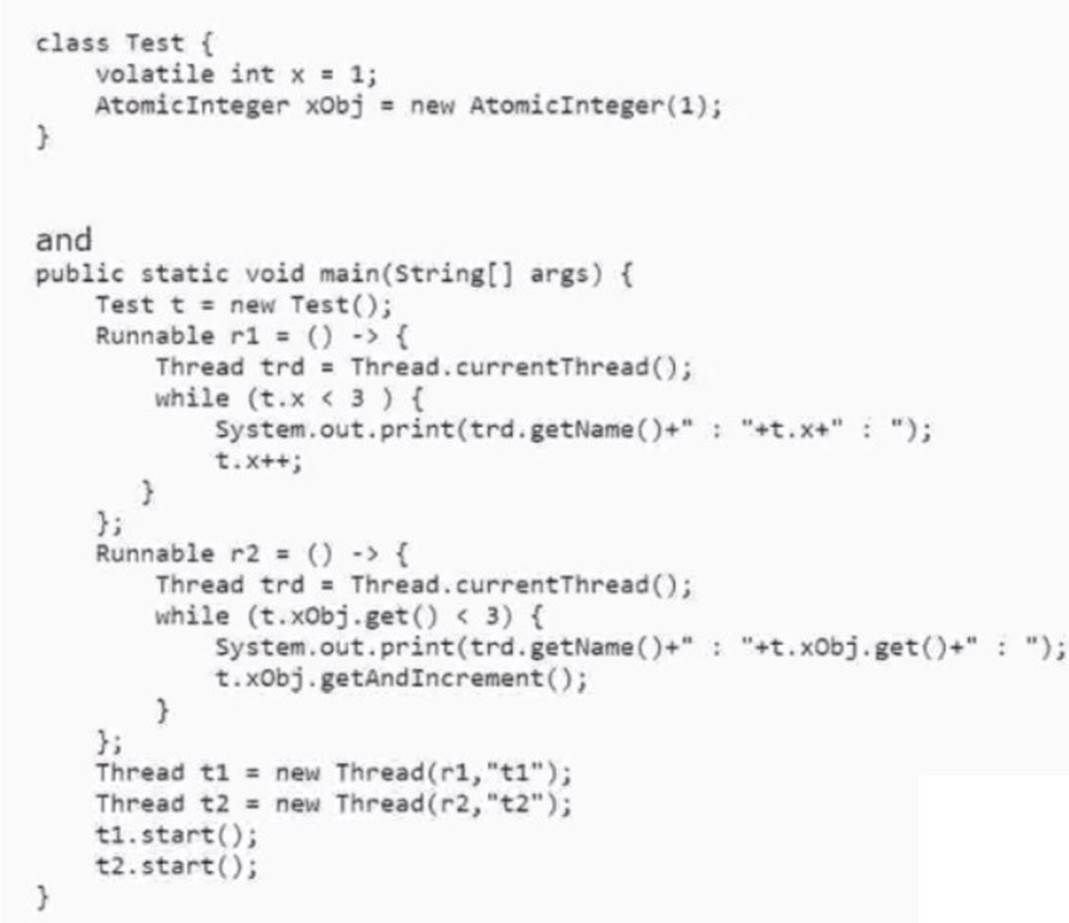
Which is true?
- A. The program prints t1 : 1: t2 : 1: t1 : t2 : 2 : in random order.
- B. The program prints t1 : 1 : t2: 1 : t1 : 2 : t2: 2:
- C. The program prints t1 : 1: t2 : 1: t1 : 1 : t2 : 1 : indefinitely
- D. The program prints an exception
Answer: B
Explanation:
The code creates two threads, t1 and t2, and starts them. The threads will print their names and the value of the Atomic Integer object, x, which is initially set to 1. The threads will then increment the value of x and print their names and the new value of x. Since the threads are started at the same time, the output will be in random order.
However, the final output will always be t1 : 1 : t2: 1 : t1 : 2 : t2: 2: References: AtomicInteger (Java SE 17 & JDK 17) - Oracle
NEW QUESTION 16
......
P.S. Easily pass 1z0-829 Exam with 50 Q&As Allfreedumps.com Dumps & pdf Version, Welcome to Download the Newest Allfreedumps.com 1z0-829 Dumps: https://www.allfreedumps.com/1z0-829-dumps.html (50 New Questions)